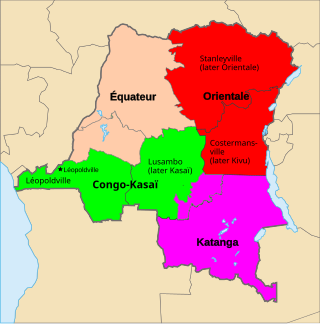| |||||
| Decades: | |||||
|---|---|---|---|---|---|
| See also: | Other events of 1970 History of the DRC | ||||
The following lists events that happened during 1970 in the Democratic Republic of the Congo .
| |||||
| Decades: | |||||
|---|---|---|---|---|---|
| See also: | Other events of 1970 History of the DRC | ||||
The following lists events that happened during 1970 in the Democratic Republic of the Congo .
| Date | event |
|---|---|
| The Compagnie du chemin de fer du bas-Congo au Katanga was taken over the Compagnie de chemin de fer de Kinshasa-Dilolo-Lubumbashi (KDL). | |
| 5 August | Barthélemy Mukenge (1925–2018) appointed governor of Kivu Province. [1] |
| 1 November | In the 1970 Democratic Republic of the Congo presidential election the sole candidate, Mobutu Sese Seko won with slightly more votes than the number of eligible voters, [2] |
| 15 November | In the 1970 Democratic Republic of the Congo parliamentary election 99% of those casting valid votes approved the Popular Movement of the Revolution (MPR) list. The MPR was the only party allowed to field candidates- |

Politics of the Democratic Republic of Congo take place in a framework of a republic in transition from a civil war to a semi-presidential republic.

Kinshasa is the capital and largest city of the Democratic Republic of the Congo. Once a site of fishing and trading villages along the Congo River, Kinshasa is now one of the world's fastest-growing megacities. With an estimated population of 16 million residents, it's the most densely populated city in the DRC and the most populous city in Africa. It is Africa's third-largest metropolitan area and the leading economic, political, and cultural center of the DRC. It houses several industries, including low-tech manufacturing, such as such as plastic and foamwares, toilet paper, and bottled water, banking, and entertainment. The city also hosts some of DRC's significant institutional buildings, such as the Palais du Peuple, Palais de la Nation, Court of Cassation, Constitutional Court, Cité de l'Union Africaine, Palais de Marbre, Stade des Martyrs, Immeuble du Gouvernement, and multiple federal departments and agencies.
ISO 3166-2:CD is the entry for the Democratic Republic of the Congo in ISO 3166-2, part of the ISO 3166 standard published by the International Organization for Standardization (ISO), which defines codes for the names of the principal subdivisions of all countries coded in ISO 3166-1.

Équateur was a province in the northwest of the Belgian Congo and the successor Republic of the Congo, now known as Democratic Republic of the Congo. It had its origins in the Équateur District of the Congo Free State, the private property of King Leopold II of Belgium. It was upgraded to the status of a province in 1917. Between 1933 and 1947 it was named Coquilhatville. In 1962 it was divided into three smaller provinces, but there were recombined in 1966. Équateur was one of the eleven provinces of the Democratic Republic of the Congo until 2015, when it was split into the new, smaller Équateur province, as well as the Tshuapa, Mongala, Nord-Ubangi and Sud-Ubangi provinces.

Article 2 of the Constitution of the Democratic Republic of the Congo divides the country into the capital city of Kinshasa and 25 named provinces. It also gives the capital the status of a province. Therefore, in many contexts Kinshasa is regarded as the 26th province.

The University of Kinshasa, commonly known as UNIKIN, is one of the three major universities in the Democratic Republic of the Congo, together with the University of Kisangani and University of Lubumbashi. Originally founded in 1954 as Lovanium University during Belgian colonial rule, the current university was established following the division of the National University of Zaire (UNAZA) in 1981. It is located in Kinshasa.

The following outline is provided as an overview of and topical guide to the Democratic Republic of the Congo:
The following is a timeline of the history of the city of Kinshasa, Democratic Republic of the Congo.

Haut-Lomami District was a district of the pre-2015 Katanga Province in the Democratic Republic of the Congo. The district dates back to the days of the Belgian Congo. At its greatest extent it roughly corresponded to the northern part of the current Lualaba Province and to the present Haut-Lomami Province.
The following lists events that happened during 1964 in the Republic of the Congo (Léopoldville).
The following lists events that happened during 1931 in the Belgian Congo.
The following lists events that happened during 1966 in the Democratic Republic of the Congo.
The following lists events that happened during 1910 in the Belgian Congo.
The following lists events that happened during 1921 in the Belgian Congo.
The following lists events that happened during 1958 in the Belgian Congo.
The following lists events that happened during 1960 in the Belgian Congo.
The following lists events that happened during 1961 in the Republic of the Congo (Léopoldville).
The following lists events that happened during 1968 in the Democratic Republic of the Congo.